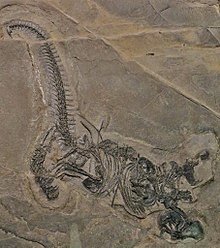Drepanosaurus unguicaudatus
|
Drepanosaurus Temporal range: Late Triassic |
|
|---|---|
 |
|
| Fossil | |
| Scientific classification | |
| Kingdom: | Animalia |
| Phylum: | Chordata |
| Class: | Reptilia |
| Family: | †Drepanosauridae |
| Genus: |
†Drepanosaurus Pinna, 1979 |
| Species: | †D. unguicaudatus |
| Binomial name | |
|
Drepanosaurus unguicaudatus Pinna, 1979 |
|
Drepanosaurus (Dre-pan-o-sore-us) is a genus of arboreal (tree-dwelling) reptile that lived during the Triassic Period. Drepanosaurus is a genus of Drepanosauridae, a group of diapsid reptiles known for their prehensile tails. Only one adult Drepanosaurus specimen and two immature specimens have ever been found and all lacked a head and neck. Drepanosaurus was probably an insectivore, and lived in a coastal environment in what is now modern day Italy, as well as in a streamside environment in the midwestern United States.
A full sized adult Drepanosaurus had a length of about half a meter or 45 to 50 cm.
In general, all drepanosaurs can be characterized as having long, gracile necks with a lightly built triangular skull that superficially resembles those of birds. They also have heavy bodies, with fused vertebrae up into a ridge over their shoulders. Their limbs can be described as chameleon-like with grasping hands and feet. Their long tails are tall and narrow with the possibility of containing a tail tip that has been modified into a claw.
Drepanosaurus is known to have a huge claw on the index finger of each hand along with the tail claw. The skull of Drepanosaurus has never been found and is still unknown, however, the skulls of other drepanosaurs like Megalancosaurus give us an idea of what the skull of Drepanosaurus might look like. Looking at Megalancosaurus's skull shows that the claws of each index finger were probably the size of the entire head of Drepanosaurus and a bird like jaw and head shape.
The forelimb of Drepanosaurus is highly modified compared to other vertebrates and very robust. Its ulna was altered from being a forearm bone into an odd crescent shaped site for muscle attachment. The role played by the ulna in most tetrapods is replaced by an elongated carpal bone. Additional musculature would be attached to the high withers that characterized Drepanosaurus and its close relatives.
A clue to the purpose of these large muscles can be found on its hand. The animal's "index finger" bore a large claw reminiscent of those born by dinosaurs such as Noasaurus and Baryonyx. However it is more likely that Drepanosaurus used its claw like the modern pygmy anteater, tearing through bark and insect nests to find invertebrate prey. Some researchers have forwarded the more far-fetched proposal that the claw was used to excavate burrows, but this is not unanimously agreed upon.
...
Wikipedia
